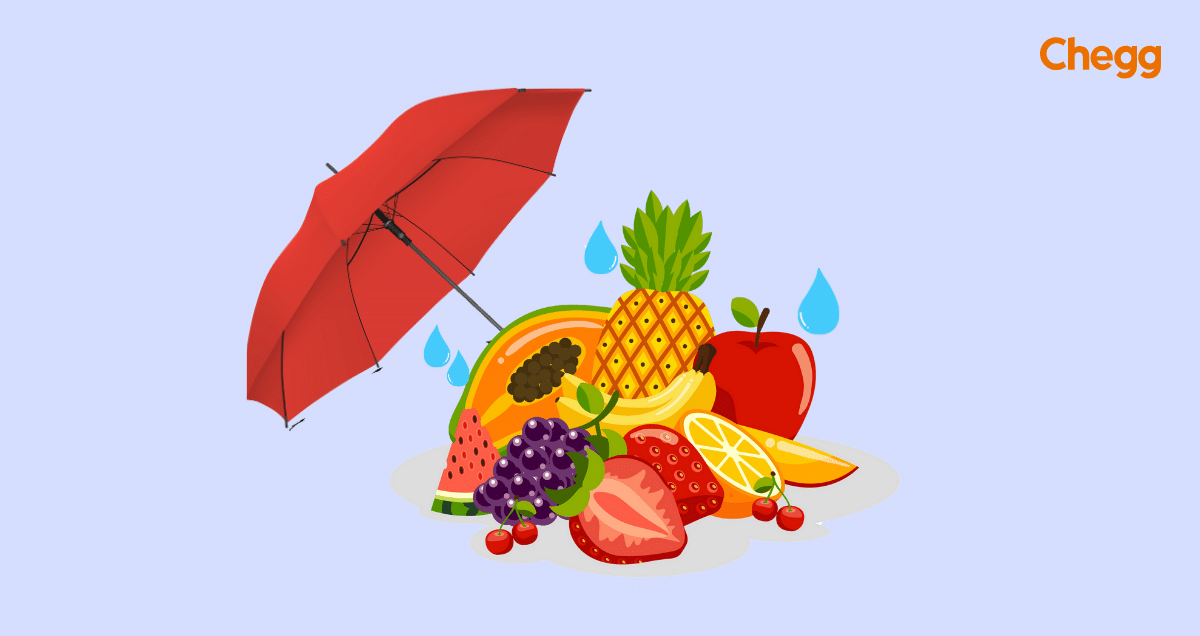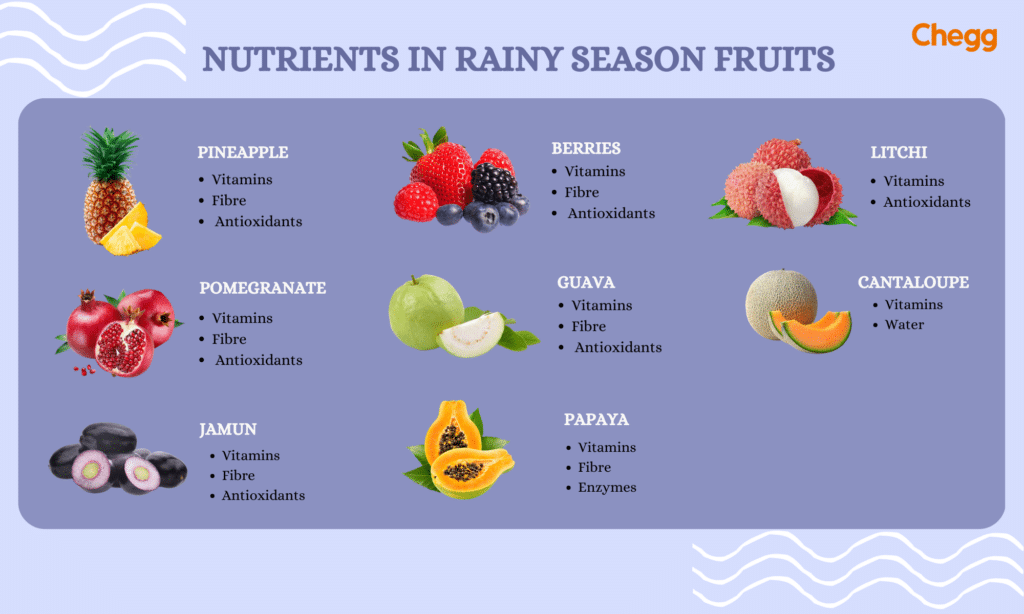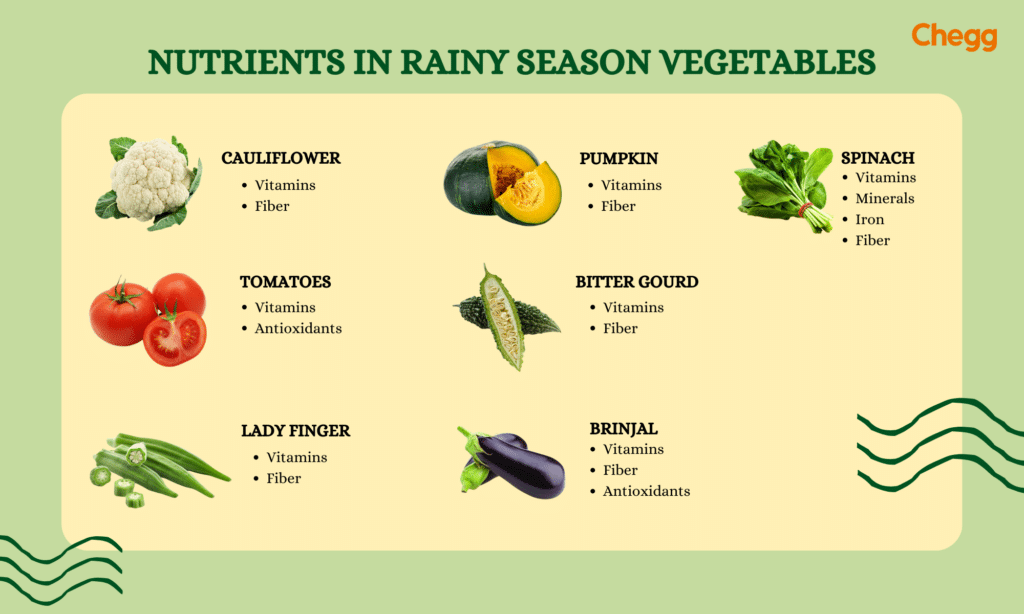Home » General Knowledge » Rainy Season Fruits in India: Monsoon Melodies
Rainy Season Fruits in India: Monsoon Melodies

Table of Contents
Rainy Seasons
In India, the rainy season is a period of relief and transformation. The land comes alive with lush foliage and glittering raindrops as the blazing summer heat gives way to monsoon rainfall. This annual occurrence refills water sources and revitalizes the agricultural landscape. The rains bring many fruits in the rainy season in India, making this season a culinary treat for many people around the country.
Definition of Rainy Season Fruits
Rainy season fruits in India are tasty, healthy, and grow during the monsoon season. When rain showers nourish the soil and supply the necessary moisture for their growth, these fruits ripen and become available. They are renowned for their refreshing taste, high water content, and distinctive flavours. It aids in combating humid and wet conditions. Fruits in rainy seasons aren’t only delicious but also excessive in nutrients, minerals, and antioxidants. They assist with general health all through this time of 12 months.
Importance of Rainy Season Fruits and Why They Are Popular?
Fruits in rainy seasons are essential in India due to their seasonality and multiple benefits. These fruits are high in critical vitamins, minerals, and antioxidants. They assist in building immunity and combat infections common during the monsoon season. In humid temperatures, its high water content keeps people hydrated. Furthermore, they bring diversity to the diet and help to maintain a balanced and nutritious consumption. These fruits also benefit local agriculture by offering a source of income for many farmers.
Rainy Season Fruits and Vegetables in India
During India’s monsoon season, many delectable fruits and vegetables thrive, adorning the gastronomic landscape. Mangoes, lychees, and Jamuns provide a sweet and tangy reprieve throughout the rainy season. Simultaneously, vegetables such as spinach, bitter gourd, and okra add a variety of textures and flavours to traditional recipes. These fruits in rainy seasons tempt the palate and provide nutritious value. They are high in vitamins, minerals, and antioxidants, which help increase immunity and overall health. These rain-kissed delicacies are a monument to the natural wealth and lively diversity that the Indian subcontinent experiences during the monsoon season.
Also Read :-
Everything To Know About Monsoon Season in India
Seasons in India : Season Cycle, Types and Names.
Summer Season Fruits in India | Refreshing Indian Fruits
Fruits in Rainy Season
These popular wet-season fruits have extensive flavours and several health blessings, including better immunity, digestion, pores, and skin health. They are high in critical vitamins, materials, antioxidants, and nutritional fibre, making them a superb addition to a well-balanced and healthful food plan throughout the monsoon season. This table includes rainy season fruits in India, including their name, description, area and soil needs, health advantages, and nutritional content:

| Fruit | Description | Area and Soil Requirement | Benefits for Health | Nutrition Content | |
| Pineapple | Color: Yellow Taste: Sweet and tangy, tropical | Area: Grows in various regions Soil: Well-draining, loamy soil | It is high in vitamin C and improves digestion. Improves immunity and provides energy. Tropical sweetness gives you energy. Antioxidants promote healthy skin. | Vitamins | |
| Fibre | |||||
| Antioxidants | |||||
| Litchi | Color: Translucent, white Taste: Sweet and slightly | Area: Thrives in subtropical areas Soil: Deep, well-drained soil | A high vitamin C content benefits the skin. Increases immunity and fights illnesses. Sweet and transparent, it hydrates. It fights infections and rejuvenates. | Vitamins | |
| Antioxidants | |||||
| Jamun | Color: Dark purple-black Taste: Sweet and tangy | Area: Grows in various regions Soil: Well-drained, loamy soil | Diabetes is managed, and digestion is aided. Antioxidants improve skin health. The sweet-tangy flavor promotes heart health. | Vitamins | |
| Antioxidants | |||||
| Fiber | |||||
| Guava | Color: Green to pink Taste: Sweet with a unique | Area: Grows in diverse climates Soil: Well-drained and fertile soil | Immune booster due to high vitamin C content. Aids digestion and weight management. The distinct sweet flavor supports healthy skin. | Vitamins | |
| Antioxidants | |||||
| Fiber | |||||
| Berries | Color: Various varieties (blue, red, and purple) Taste: Sweet and tart | Area: Suitable for a range of climates Soil: Well-drained, acidic soil | It is prosperous in antioxidants, supports heart health, and improves skin. It enhances memory, aids digestion, and provides hydration. It supports eye care, helps to manage weight, and increases immunity. | Vitamins | |
| Fiber | |||||
| Antioxidants | |||||
| Papaya | Color: Orange Taste: Sweet and slightly | Area: Grows in diverse climates Soil: Well-drained and fertile soil | Contains digestive enzymes, boosts immunity, and aids digestion It supports skin health, provides energy, and aids wound healing | Vitamins | |
| Fiber | |||||
| Enzymes | |||||
| Pomegranate | Color: Ruby-red Taste: Sweet and tangy | Area: Suitable for a range of climates Soil: Well-drained, loamy soil | Antioxidants help to maintain heart health. The sweet-tangy flavor improves memory. It improves skin and provides essential hydration. | Vitamins | |
| Antioxidants | |||||
| Fiber | |||||
| Cantaloupe | Color: Orange Taste: Sweet and refreshing | Area: Grows in various regions Soil: Well-drained, sandy soil | A high water content is beneficial to kidney health. Sweet and refreshing, it promotes weight loss. It cools the body while being low in calories. | Vitamins | |
| Water |
Rainy Season Vegetables
These rainy-season veggies are essential in Indian cuisine and provide a variety of flavors and health advantages. They aren’t the most straightforward, tasty additions to food but contain critical factors that help a nicely balanced and nutritious weight loss program. During the monsoon season, devour those vegetables to live wholesomely and enjoy the flavors in your meal. This table includes rainy season vegetables in India, including their name, description, area and soil needs, health advantages, and nutritional content:

| Vegetable | Description | Area and Soil Requirement | Benefits for Health | Nutrition Content | |
| Spinach | Color: Dark green Taste: Mild and slightly earthy | Area: Grows in various regions Soil: Well-drained and fertile soil | It is high in iron and vitamins, supports bone health, and boosts immunity. It supports digestion, aids in weight management, and improves skin. | Vitamins | |
| Minerals | |||||
| Iron | |||||
| Fiber | |||||
| Bitter Gourd | Color: Green Taste: Bitter | Area: Thrives in tropical areas Soil: Well-drained, loamy soil | Manages blood sugar levels. Aids in digestion. Promotes weight loss. It supports liver health and enhances immunity. | Vitamins | |
| Fiber | |||||
| Lady’s Finger | Color: Green Taste: Mild and slightly slimy | Area: Suitable for a range of climates Soil: Well-drained, loamy soil | It is high in dietary fiber, aids digestion, and promotes heart health. It supports weight management, maintains eye health, and boosts immunity. | Vitamins | |
| Fiber | |||||
| Cauliflower | Color: White Taste: Mild and slightly nutty | Area: Grows in various regions Soil: Well-drained and fertile soil | Affluent in vitamin C, it aids in digestion and supports bone health It is low in calories, promotes healthy skin, and aids weight management. | Vitamins | |
| Fiber | |||||
| Brinjal (Eggplant) | Color: Purple Taste: Slightly bitter taste | Grows in various regions Soil: Well-drained and fertile soil | It is low in calories and supports heart health. It aids in digestion. It is rich in antioxidants. Promotes weight loss and enhances brain health. | Vitamins | |
| Fiber | |||||
| Antioxidants | |||||
| Tomatoes | Color: Green and Red Taste: Tangy and slightly sweet | Area: Grows in various regions Soil: Well-drained, loamy soil | Affluent in vitamin C, it supports heart health and improves skin It is low in calories, promotes eye care, and aids digestion.. | Vitamins | |
| Antioxidants | |||||
| Pumpkin | Color: Orange Taste: Mild and slightly sweet | Area: Suitable for a range of climates Soil: Well-drained, fertile soil | High in beta-carotene, it aids in weight management and supports digestion It provides hydration, supports skin health, and boosts immunity. | Vitamins | |
| Fiber |
Rainy Season Fruits in Maharashtra
Rainy season fruits in Maharashtra give a delicious and juicy experience as the rain-soaked earth breathes life into the orchards and fields, making it a culinary paradise for fruit experts. This table contains information about Maharashtra’s rainy season fruits, including their name, description, area and soil requirements, health advantages, and nutritional content:
| Fruit Name | Description | Area and Soil Requirement | Benefits for Health | Nutritional Content |
| Alphonso Mango | Yellow skin with a sweet, aromatic taste | Thrives in the Konkan region | It boosts immunity and supports eye health. It promotes digestion and enhances skin growth. | Vitamins |
| Minerals | ||||
| Antioxidants | ||||
| Fiber | ||||
| Jamun | Dark purple to black, and the taste is sweet and tangy. | Grows in various regions | It manages diabetes. It aids digestion and improves skin. It is rich in antioxidants and supports heart health. | Vitamins |
| Antioxidants | ||||
| Fiber | ||||
| Guava | Green with a distinct aroma and sweet taste | Suitable for diverse climates | It is high in vitamin C and boosts immunity. It aids in digestion and promotes weight management. It supports skin health. | Vitamins |
| Antioxidants | ||||
| Fiber | ||||
| Pomelo | Large citrus fruit with a mild sweet taste | Thrives in warm climates | Rich in vitamin C aids digestion, supports eye health, promotes weight management, and enhances skin health. | Antioxidants |
| Vitamins | ||||
| Custard Apple | Green, scaly skin, sweet and creamy flesh | Suitable for subtropical regions | It supports digestion, provides energy, aids weight management, enhances skin health, and boosts immunity. | Fiber |
| Vitamins | ||||
| Kokum | Small purple fruit with a tangy taste | Grows in the Konkan region | It aids in digestion and promotes heart health. It supports weight management. It provides relief from acidity and enhances skin health. | Antioxidants |
| Vitamins | ||||
| Karvanda (Carissa) | Small red to black fruit with a tart flavor | Thrives in various regions | High in vitamin C. It aids digestion and supports weight management. It boosts immunity and improves skin health. | Vitamins |
| Antioxidants | ||||
| Fiber | ||||
| Sapota (Chikoo) | Brown skin with sweet, grainy flesh | Suitable for diverse climates | It provides energy. It aids in digestion. It supports bone health. It boosts immunity and enhances skin growth. | Vitamins |
| Minerals | ||||
| Fiber | ||||
| Starfruit | Yellow with a unique star-like shape | Thrives in warm climates | Rich in vitamin C, it aids digestion, supports eye health, promotes weight management, and enhances skin health. | Vitamins |
| Fiber | ||||
| Indian Gooseberry (Amla) | Green, sour, and tangy | Suitable for diverse climates | High in vitamin C. It boosts immunity and aids in digestion. It supports heart health and enhances hair and skin growth. | Vitamins |
| Fiber | ||||
| Antioxidants | ||||
| Fig (Anjeer) | Green or purple skin with sweet, seedy flesh | Thrives in warm climates | It supports digestion, provides energy, aids weight management, enhances skin health, and supports heart health. | Fiber |
| Vitamins | ||||
| Jackfruit (Phanas) | Large fruit with sweet, fleshy pods | Suitable for tropical regions | Rich in vitamin C. Aids in digestion promote weight management. It supports heart health and enhances skin health. | Vitamins |
| Minerals | ||||
| Fiber | ||||
| Indian Jujube (Ber) | Small, round fruit with a sweet and tangy taste | Grows in various regions | Aids in digestion. Supports heart health. Boosts immunity and enhances skin health. Provides energy. | Vitamins |
| Antioxidants | ||||
| Fiber | ||||
| Tamarind (Imli) | Brown pods with a sour, tangy flavor | Suitable for diverse climates | It supports digestion, relieves acidity, enhances heart health, and aids weight management. | Vitamins |
| Minerals | ||||
| Fibers |
Foods to Avoid During the Rainy Season
The monsoon season brings with it a delightful change in scenery, but it also requires some adjustments to your diet. Here’s a list of foods to be cautious about during this time:
Street Stall Staples:
- Pani Puri, Gol Gappa, Puchka: These beloved street snacks are unfortunately breeding grounds for bacteria during the monsoon. Dust, flies, and potentially contaminated water at roadside stalls can lead to unpleasant stomach upsets. Stick to home-prepared versions or skip them altogether this season.
Digestive Downers:
- Fried Foods (Pakoras, Samosas, etc.): Monsoon weather can slow down your digestion. Oily and fried foods like these can further clog your digestive system, leading to heartburn and indigestion. Opt for lighter, steamed or grilled options instead.
Seafood Savvy:
- Seafood: The monsoon season coincides with breeding seasons for many sea creatures. This can make fresh seafood harder to find and increase the risk of consuming stale or contaminated fish, leading to food poisoning. Be extra cautious about the source of your seafood during this time.
Fresh Produce Precautions:
- Pre-cut Fruits and Salads: Exposed fruits and salads are magnets for flies and other pests during the monsoon. Opt for whole fruits with peels you can wash thoroughly at home.
- Leafy Greens: While leafy greens are a healthy choice year-round, they require extra care during the monsoon. Heavy rains can lead to dirty vegetables and improper storage can introduce harmful bacteria. Stick to hardier vegetables like root vegetables or brightly colored peppers during this season.
Conclusion
In India, the rainy season is a cultural and culinary celebration and a climatic occurrence. The arrival of a vast assortment of fruits that are not only a treat to the tongue but also a source of essential sustenance marks the seasonal shift from sweltering summers to soothing monsoons. These rainy season fruits and vegetables in India symbolize nature’s richness, from the delicious mangoes, known as the “king of fruits,” to the sweet and tart Jamuns. They offer various fitness blessings, improved immunity, progressed digestion, and crucial nutrients and antioxidants.
These culminations are more than only a supply of nutrition; they hyperlink to our past. The monsoons breathe new life into the dry earth and lift our spirits. We celebrate the combination of nature and culture as we savor these luscious gems, making the rainy season in India a time of restoration for both body and soul.
FAQs: Rainy season fruits in India
Guava Juice, the Super Fruit. Packed with nutrients, every 100g of guava contains 40g of magnesium and nearly four times the Vitamin C found in an orange.
Avoid unpasteurized milk and milk-based desserts during the rainy season to prevent stomach infections.
Got a question on this topic?